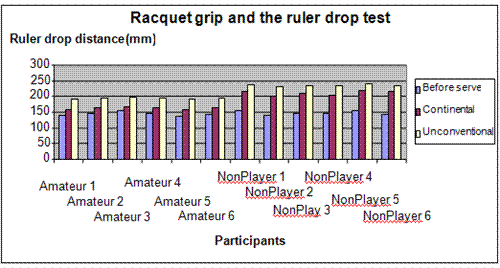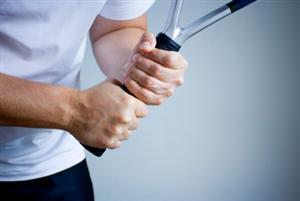| Complexity level: | 8 |
| Project cost ($): | 60 |
| Time required: | 1 hour to prepare, 2 days for the science project experiment |
| Material availability: | Easily found at a sports store |
| Safety concerns: | Basic safety requirements |
Hypothesis
Tennis players will experience less muscle fatigue using the standard continental grips.
Overview
Tennis racquet grip
There are several methods for gripping a tennis racquet. The most common methods of gripping the racquet are the continental, eastern and western grips. Normally, a tennis player changes the method of gripping his racquet several times depending on the type of shot that he will be taking.
The handle of the tennis racquet is octagonal in shape. If the handle was square, its sharp corners would hurt the player's hand and if it were round, there would not be enough friction for him to grip the handle firmly. The size of the handle is also important. A small handle will require the player to grip the handle harder and this results in greater muscle fatigue.
The style of gripping a racquet normally depends on how the player plans to serve or return the ball. The continental grip is obtained by holding the racquet like an axe. This is the reason why it is nicknamed the "chopper grip". It is used at professional levels to execute a "flat" serve with little or no ball spin.
Scientific Terms
Materials
The materials required for this science fair project:
- 6 amateur tennis players
- 6 non-players
- 2 dozen tennis balls
- 1 tennis racquet
- 1 tennis court
- 1 tennis coach
- 1 meter long ruler
- An assistant
Procedure
1. For this science fair project, the independent variable is the type of grip used to hold the tennis racquet – continental or unconventional. The dependent variable is the amount of muscle fatigue experienced by the participants. This was determined with the ruler drop test. The constants (control variables) are the number of serves that were executed, the grip style and the weight of the racquet.
2. The muscle reflexes of the 12 participants is tested using the ruler drop test. The participants were made to open their index finger and thumbs in a V-shape horizontally. The 1 meter ruler as held by the assistant vertically with the base at the center, right in between the index finger and the thumb of the participant. Without warning the assistant dropped the ruler for the participant to catch by closing his index finger and thumb. The distance of fall was the point of contact along the ruler . Each participant as given 3 attempts and the shortest reading was recorded in the table below.
3. Each of the participants then served tennis balls 20 times, whilst holding the racket with the continental grip. The tennis coach helped to ensure that the participants gripped the racquet correctly. After 20 serves, procedure 2 was repeated to check the level of hand-muscle fatigue of the participants. The results were recorded.
4. On the next day, procedure 3 was again repeated using the unconventional grip. The tennis coach again helped to monitor and ensure that participants maintained a consistent grip. The results of the ruler drop test after 20 serves were recorded.

Results
The average drop distance for the tennis players was 163mm and for non-players, 211mm. The participants’ reflexes were slower after having used the unconventional grip, producing an average drop distance of 194mm for the tennis players and 235mm for the non tennis players.
|
Racquet grip |
The ruler drop test done after the 20 serves using continental and unconventional grip (rounded down to the nearest mm) |
|||||||||||
|
Amateur 1 |
Amateur 2 |
Amateur 3 |
Amateur 4 |
Amateur 5 |
Amateur 6 |
NonPlay 1 |
NonPlay 2 |
NonPlay 3 |
NonPlay 4 |
NonPlay 5 |
NonPlay 6 |
|
|
Before serve |
139 |
145 |
152 |
146 |
135 |
143 |
152 |
139 |
145 |
148 |
153 |
144 |
|
Continental |
158 |
166 |
169 |
163 |
158 |
165 |
215 |
201 |
210 |
205 |
220 |
216 |
|
Unconventional |
189 |
194 |
198 |
195 |
191 |
195 |
238 |
229 |
235 |
235 |
241 |
233 |
The chart below represents the result of our science project experiment.

Conclusion
The hypothesis that tennis players will experience less muscle fatigue by using the standard continental grip, is proven to be true. In our experiment, we proved that this is true when using the continental grip to serve.
Learning the proper method of holding the racquet and the correct technique of executing a serve or return shot is important, in order for a player to excel in tennis or any other similar sports. Using the proper technique minimizes the risks of sports injuries and enables us to better enjoy the game.
Also consider
In our experiment, we only evaluated the effect of different grip styles, on serving. We can also evaluate how the different styles of gripping a tennis racquet affect other types of strokes, such as the forehand topspin, the backhand topspin, the volley, half volley, overhead smash, drop shot etc.
Try also repeating this science fair project, this time, using tennis rackets of different grip sizes.
The science project experiment can also be used to evaluate the method of gripping sporting equipment for other racquet games such as baseball, squash or golf.
References
Grip (tennis) - http://en.wikipedia.org/wiki/Grip_(tennis)
How to swing a tennis racquet - http://www.ehow.com/how_2307394_swing-tennis-racquet.html

